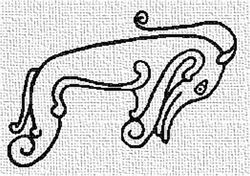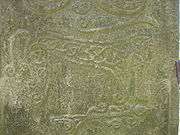
Pictish Beast
Encyclopedia


The Pictish Beast is an artistic representation of an animal
Animal
Animals are a major group of multicellular, eukaryotic organisms of the kingdom Animalia or Metazoa. Their body plan eventually becomes fixed as they develop, although some undergo a process of metamorphosis later on in their life. Most animals are motile, meaning they can move spontaneously and...
, and is depicted on Pictish symbol stones. It is not easily identifiable with any real animal, but resembles a seahorse
Seahorse
Seahorses compose the fish genus Hippocampus within the family Syngnathidae, in order Syngnathiformes. Syngnathidae also includes the pipefishes. "Hippocampus" comes from the Ancient Greek hippos meaning "horse" and kampos meaning “sea monster”.There are nearly 50 species of seahorse...
, especially when depicted upright. Suggestions have included a dolphin
Dolphin
Dolphins are marine mammals that are closely related to whales and porpoises. There are almost forty species of dolphin in 17 genera. They vary in size from and , up to and . They are found worldwide, mostly in the shallower seas of the continental shelves, and are carnivores, mostly eating...
, a kelpie
Kelpie
The kelpie is a supernatural water horse from Celtic folklore that is believed to haunt the rivers and lochs of Scotland and Ireland; the name may be from Scottish Gaelic cailpeach or colpach "heifer, colt".-Description and behaviour:...
(or each uisge
Each uisge
The each uisge is a mythological Scottish water spirit, called the Aughisky in Ireland. It is similar to the kelpie, but far more dangerous.The Each Uisge, a supernatural water horse found in the Highlands of Scotland, is supposedly the most dangerous water-dwelling creature in the British Isles...
) and even the Loch Ness Monster
Loch Ness Monster
The Loch Ness Monster is a cryptid that is reputed to inhabit Loch Ness in the Scottish Highlands. It is similar to other supposed lake monsters in Scotland and elsewhere, though its description varies from one account to the next....
.
Recent thinking is that it may be related to the design of dragonesque brooches, S-shaped pieces of jewelry from the mid-1st to 2nd century CE that depict double-headed animals with swirled snouts and distinctive ears. These have been found in southern Scotland and northern England. The strongest evidence for this is the presence on the Mortlach 2 stone of a symbol very similar to such a brooch, next to and in the same alignment as a Pictish Beast.
The Pictish Beast comprises roughly 2 in 5 of all Pictish
Picts
The Picts were a group of Late Iron Age and Early Mediaeval people living in what is now eastern and northern Scotland. There is an association with the distribution of brochs, place names beginning 'Pit-', for instance Pitlochry, and Pictish stones. They are recorded from before the Roman conquest...
animal depictions, and so was obviously of great importance.
It is thought that it was either an important figure in Pictish mythology, and/or a political symbol.

